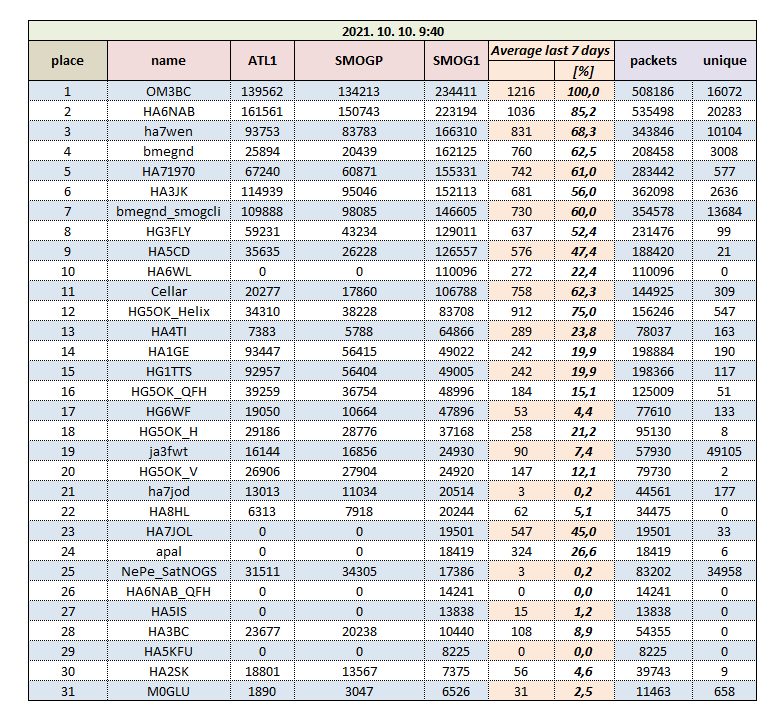
Tracking satellites
October 10th 2021
One week average of data - packet growth at SMOG - 1 HQ:

The three outstanding stations are OM3BC, HA6NAB and HG5OK respectively.
NN
October 6th 2021
Aggregated data - packet growth as of this afternoon.

Tnx HG5OK
October 2nd 2021
Another batch of data packages were uploaded to the BME HQ today.
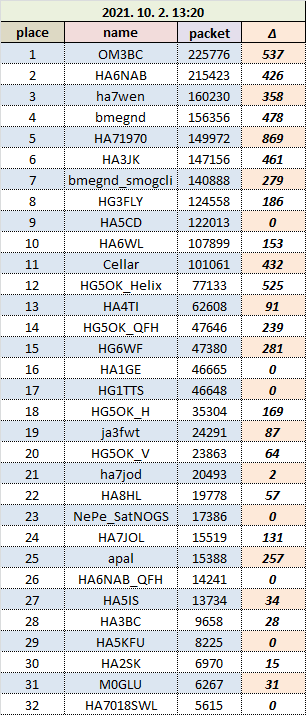
Tnx HG5OK
September 12th 2021
Here's a glimpse of the quickly growing number of data packages waiting for further processing.
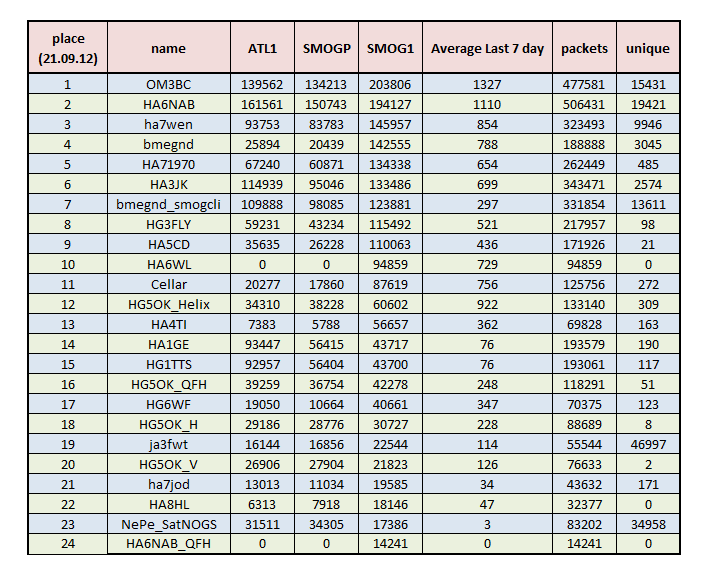
It may be surprising to note, how many data packages are collected by HG5OK Pista who uses a single bay 12.5 turns helix antenna. He has also collected more unique data packages, then the other average stations in and int the necessity of Budapest.
NN
September 3rd 2021
The SMOG - 1 dashboard shows that the amount received, decoded, and uploaded to the central database by the data packets stations after more than a quarter-million!
From this occasion, today's summary shows the activity of the follow-up stations.
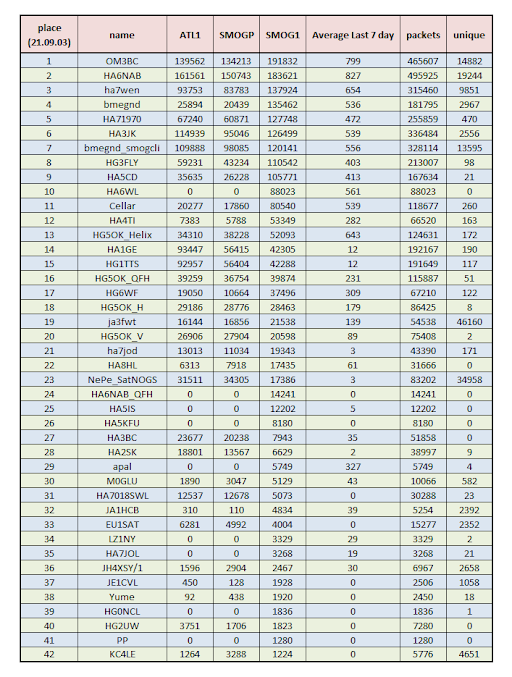
TNX HA5OK
August 24th 2021
Here is a summary of the follow-up stations of the satellite trackers who have already been struggled through the previous projects.
Many data are very remarkable, for example, those collected by JA3FWT and NePe_SatNOGS. A large number of unique data, a collection of those tens of thousands of receptions that only and alone in his station recorded and decoded.
The owners of call signs can be informed of our earlier table.
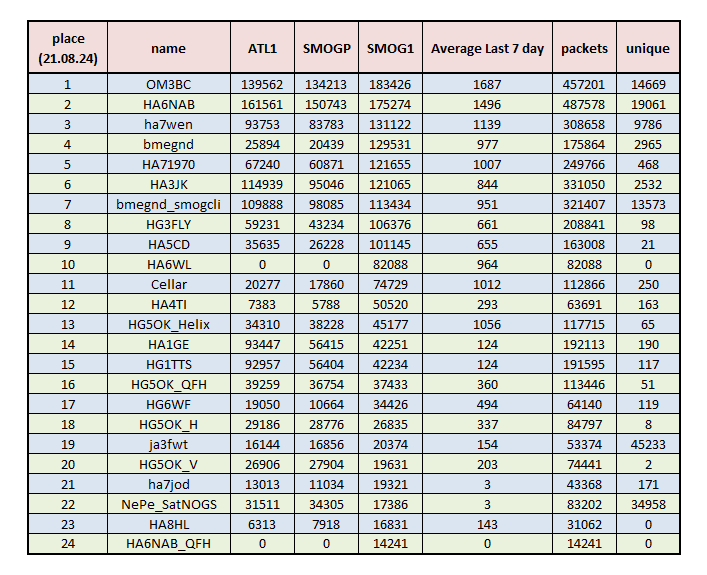
Tnx HG5OK
August 22nd 2021
HG5OK's 12 turn helix started to collect record amount of data packets. Just take a look at the latest daily achievement! It was the third of all!
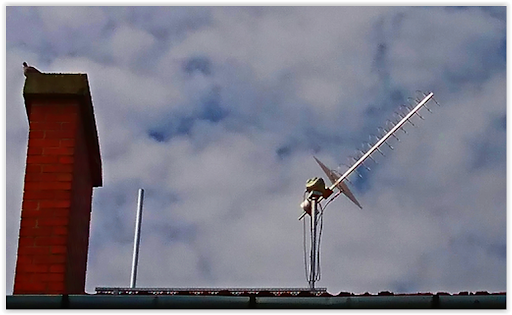

August 15th 2021
Eight diligent tracking stations have collected more than one hundred thousand data packets by this date.
The last column marked by the Greek delta shows the most recently uploaded data packets.
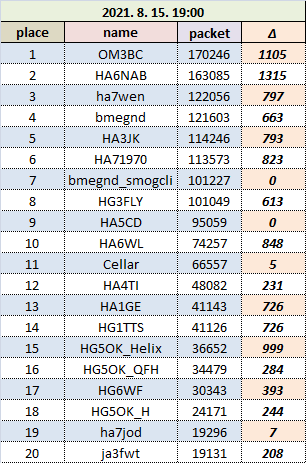
June 20th 2021
Congratulations are due to OM3BC Joska on uploading 100000 data packets to BME HQ!
May 28th 2021
HG5OK István has completed his satellite tracking 12 turn helix antenna.

May 25th 2021
SWL HA71970 Tamás introduces his satellite tracking station.
April 19th 2021
The latest twenty OSCAR designations:
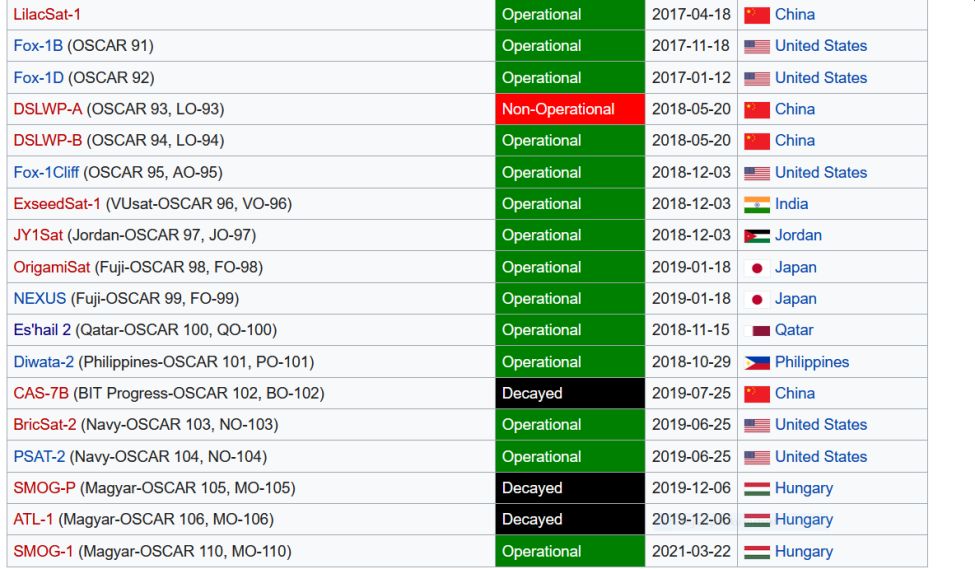
The full list can be found here:
https://en.wikipedia.org/wiki/Amateur_radio_satellite
Tnx HA5WH
April 17th 2021
Based on the SMOG-1 accelerometer data, a visualizing software has been developed by János HG5APZ and Jóska OM3BC. It provides moving pictures about the continuously changing position of the satellite. The development of the movie is going on. Please note, developer's request for some comments. Anyone may watch the recent movie on HG5APZ's server.
http://hg5apz.homelinux.org/smog1/smog.htmlApril 16th 2021
At the request of the Budapest University of Technology and Economics, AMSAT hereby designates SMOG-1 as Magyar-OSCAR 110 (MO-110). We congratulate the owners and operators, thank them for their contribution to the amateur satellite community, and wish them a long mission and continued success on this and future projects.
Look for MO-110 when refreshing TLE!
April 6th 2021
The outstanding achievement of this day is rather exact guessing of the rotation of the SMOG-1 satellite. Based on the developers' deep knowledge of the onboard system, HG5OK has fed the data provided by OM3BC into computer software which shows a spin of less than 50 sec.

April 4th 2021
The fourth Hungarian satellite, SMOG-1 is named by NORAD in its satellite list, beginning today.
A set of two-line elements (TLE) is a data format required to calculate passes to receive on-board data sent to us by satellite.
SMOG-1
1 47964U 21022AJ 21094.22551356 .00001835 00000-0 12668-3 0 9995
2 47964 97.5641 357.8713 0019474 194.7218 317.1008 15.06883922 694
Using these elements we get these observable tracks for today and tomorrow:


March 27th 2021
SMOG-1 dashboard has been made usable today.
https://gnd.bme.hu/smog1status
March 26th 2021
https://www.rtl-sdr.com/smog-1-pocketqube-satellite-successfully-launched-and-in-orbit/
March 25th 2021
After a really adventurous multi-stage launch, SMOG-1 finally started its mission today in space!
The first signs were observed by the Team above Hungary at 0:49 CET.
Based on the downloaded data, the onboard sensors measure a pleasant temperature between 10 and 35 °C and the satellite is completely healthy!
With good luck, this tiny spacecraft can provide world-unique results for years to come.
Tnx Edit Gschwindt
March 22nd 2021
SMOG-1 has flying together with 37 other satellites into orbit.
https://www.youtube.com/watch?v=J1nfIV-4_e8
March 18th 2021
The launch of a Soyuz-2 launch vehicle with a Fregat final stage from Baikonur (Kazakhstan) is scheduled for the 20th of March, 6:07 AM UTC, which will carry SMOG-1, the new Hungarian small satellite to space. (BME News)
January 6th 2021
UNISAT-7 will start soon with the Hungarian SMOG-1 PQ satellite.

September 29th 2020
SMOG-P entered the Earth’s atmosphere and completed its mission.
https://www.linkedin.com/feed/update/urn:li:activity:6716413172980445184/
September 23rd 2020
Satellite evolution graphs for today:
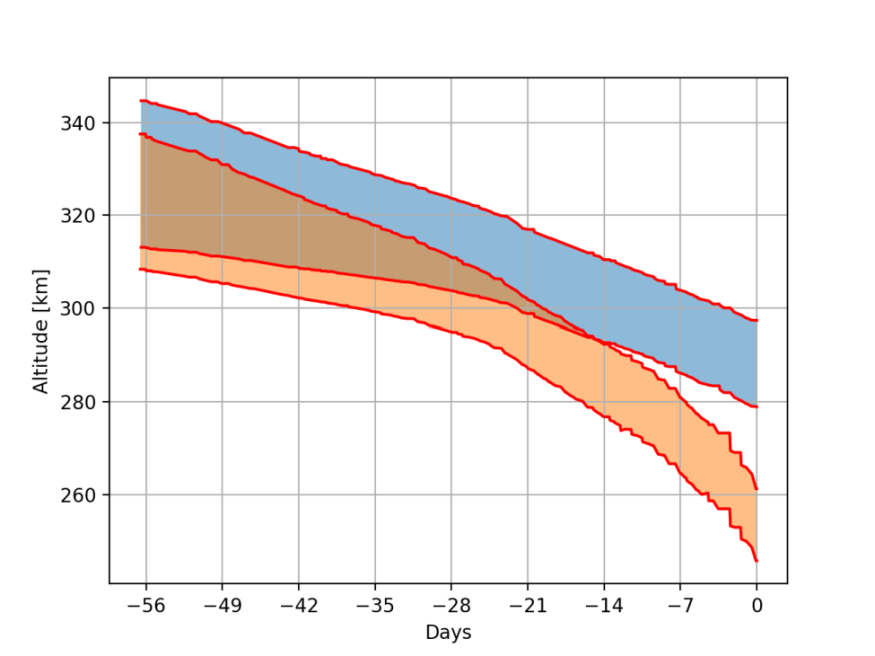
It will be interesting to check, wheather NORAD will be able to track PQ satellites while their orbits change quickly.
73
HA5CQA
September 17th 2020
According to notes of HA7GG, the movement of orbiting satellites in the height of the F regions of the ionosphere are influenced by the drag of the ionized media.
One example is the number of oxygen atoms (See the publication of Gábor Géczy HA7GG) and the changing density of ions determined by the 304-angstrom radiation of the Sun.
During the week, preceding 13th September 2020 Peter HA5CQA has produced a graph that shows the accelerating evolution of ATL-1 and SMOG-P satellites. Expectedly, the tendency of this leads to the burning of the satellites.
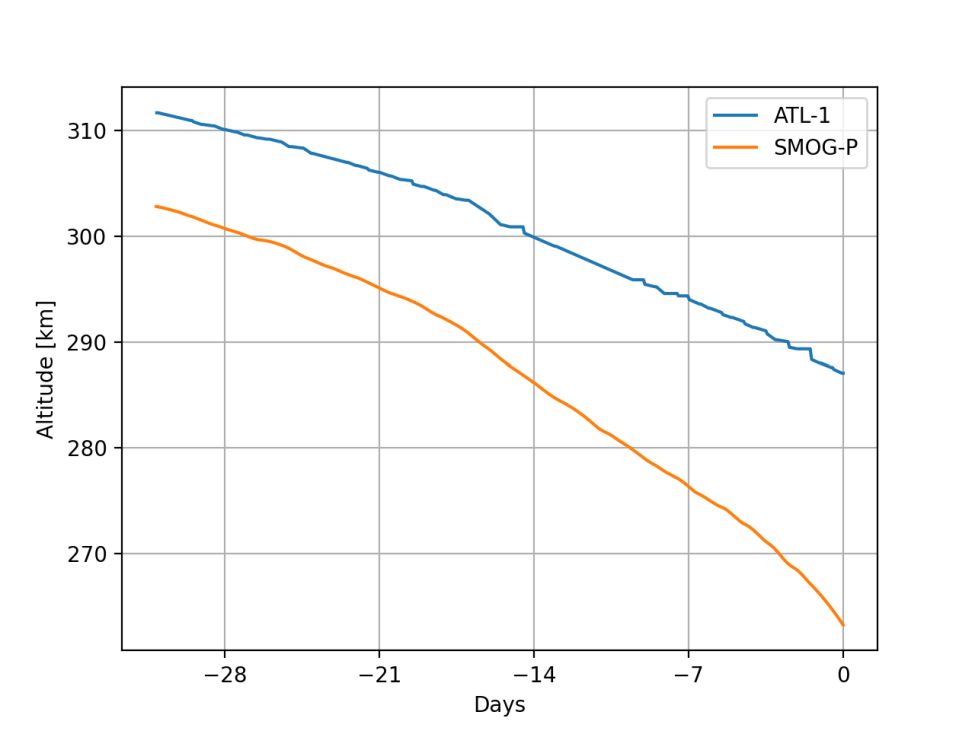
Let's take a look at the achievement of the first 30 tracking stations among all the 87, HA6NAB's at first, who has uploaded more than 300000 data packets of ATL-1 and SMOG-P. All the other tracking stations have made a huge sacrifice for the sake of collecting so many data, even during the first nine months of the operation.
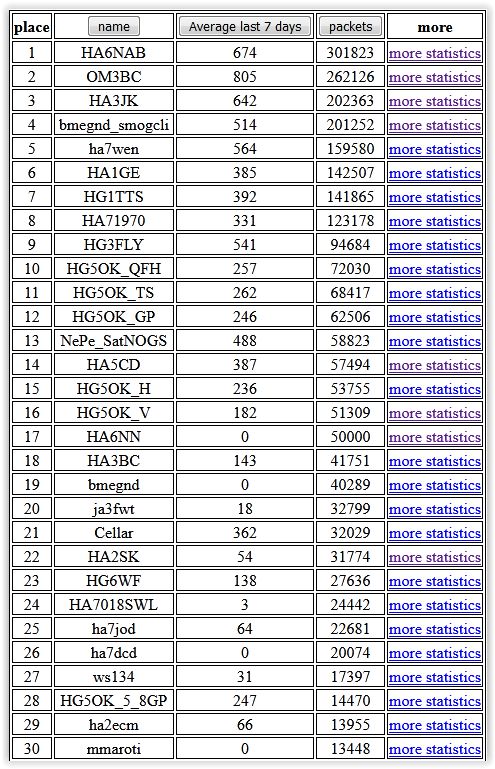
There are nine stations among the first ten. (One of them is double.) It's venerable to recognize all the six fixed testing antenna that made by HG5OK are among the first thirty, even the 5/8 lambda vertical which was able to collect almost 15000 data packets till this date. Honourable that HG1TTS and HA1GE have fought a lot to keep the 6th and 7th place. They are followed by Tamás HA71970 who has been helping others with his advice and notes while collecting so many data. HA5CD and Cellar have achieved fast advance despite their relatively late start of tracking. For whom we are all grateful, are the authors of the smogcli2 software who have been advancing in collecting data among us.
All tracking stations worth an acknowledgement, since they were all fought for building a useable tracking station -although they had the chance of tracking for a short time.
NN
August 6th 2020
As you may know and noted, we have observed some function anomalies in the operation of SMOG-P during the past months (unexpected battery discharge, reboots, system toggles, etc.). We were not able to explain what had been going on up there but despite the abnormalities, the satellite has been working perfectly and accomplished its mission.
After a several week-long investigation, I succeeded to point out what is the source of the problem and what causes the experienced anomalies.
I have written an article which summarizes the whole mission, about the causes of the anomalies and the probable states that can be observed in the future.
The article can be found on our server and its abstracts will appear in the press shortly.
http://gnd.bme.hu/smog/files/publikaciok/gabor_eps2/The_Success_Story_of_SMOG-P_Gabor_Geczy.pdf
I am herewith thank you for all your help! Many thanks to the satellite constructor team, to the plentiful amateur radio tracking stations, the upload of the countless number of data packets from which the conclusion has arisen, giving a complete picture.
I wish you a nice day today on the occasion of the launch of SMOG-P and ATL-1 satellites, eight months ago.
Regards,
Géczy Gábor HA7GG
July 29th 2020
Amateur Radio Space Race
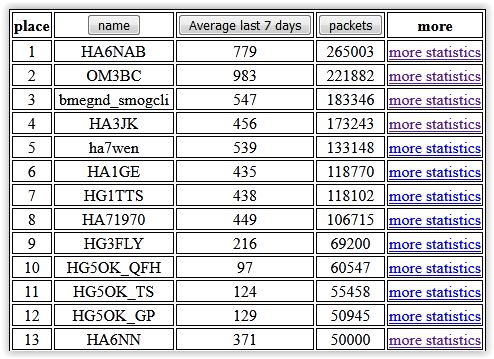
You can see the list of the satellite tracking stations that shows those who have uploaded 50000 or more data packets of SMOG-P and ATL-1 satellites to the server of BME.
These stations may be grateful for the exceptionally successful smogcli2 software which has made it possible for uploading so many data packets.
The last four stations have been using immobile antennas. HG5OK has made four of them. The second antenna at HA6NN is an LPDA.
Exceptionally great appreciations are due to the line of those tracking stations that achieved more than 100000 uploaded packets and of course HA6NAB and OM3BC who have exceeded the 200000 packets.
There are alltogether 87 tracking stations on the list with the authors of smogcli2 software among them.
https://gnd.bme.hu/gndupload/leaderboard.php
NN
July 25th 2020
YO6UO's worm-screw antenna elevation for tracking satellites:
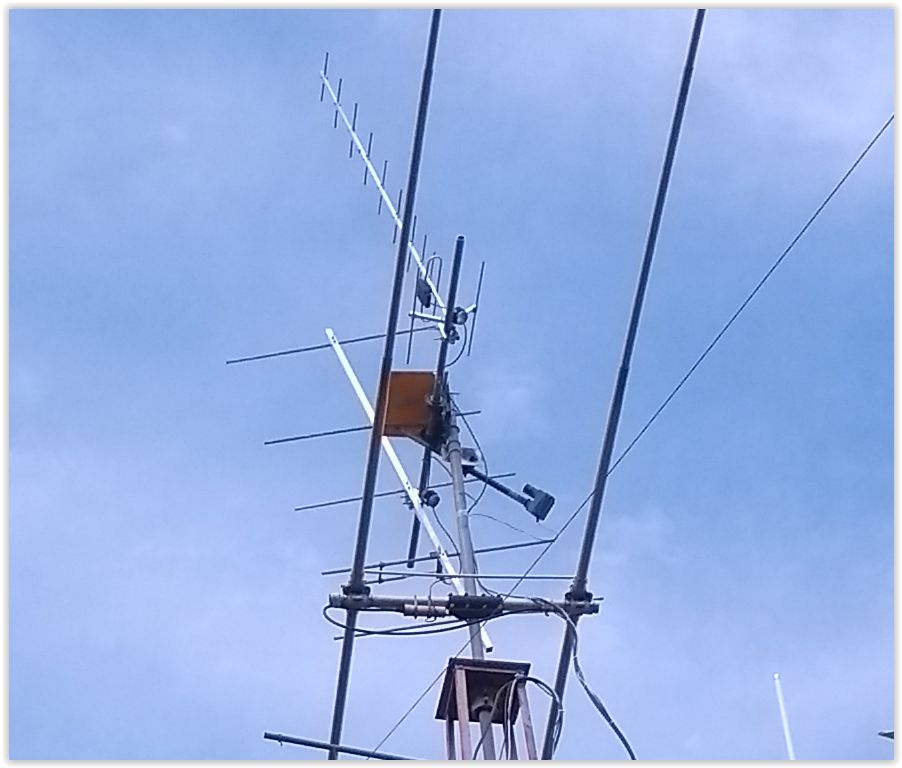
Background information: https://www.qsl.net/sv1bsx/actuator/actuator.html
July 12th 2020
Diligent tracking stations are struggling to save, decode and upload to database as much data packets as possible during each pass of BME-satellites.
Those who were able to cross magic barriers are HA6NAB 250000, OM3BC 200000 and HG6OK who has reached the quantity of 50000 uploaded data packet using his turnstile antenna.
OM3BC had had to identify a jamming TV provider and had to take official steps to have that TV channel stopped on a certain frequency.
He has designed his low noise amplifier, and he has been testing several different antennas. You can see the original PCB panel that he originally made for another project.
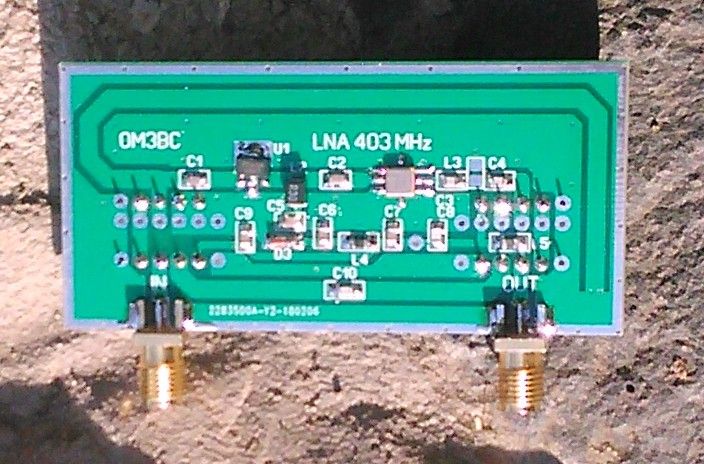
The full documentation of that LNA can be found at http://www.om3bc.com/eng.htm
June 20th 2020
I saw this line on gnd.bme.hu leaderboard:
HG5OK_QFH 370 50085
It's an outstanding achievement: to receive 50000 data packets by a fixed antenna. A direct hit was the application of a QFH antenna since the leading satellite tracking stations on the top of the leaderboard were able to decode more than 100000 data packets by using much more complicated systems.
A new design was born in Pista's workshop during the beginning of June, so others are also using this well-working antenna for tracking satellites constructed at Budapest Technical University.
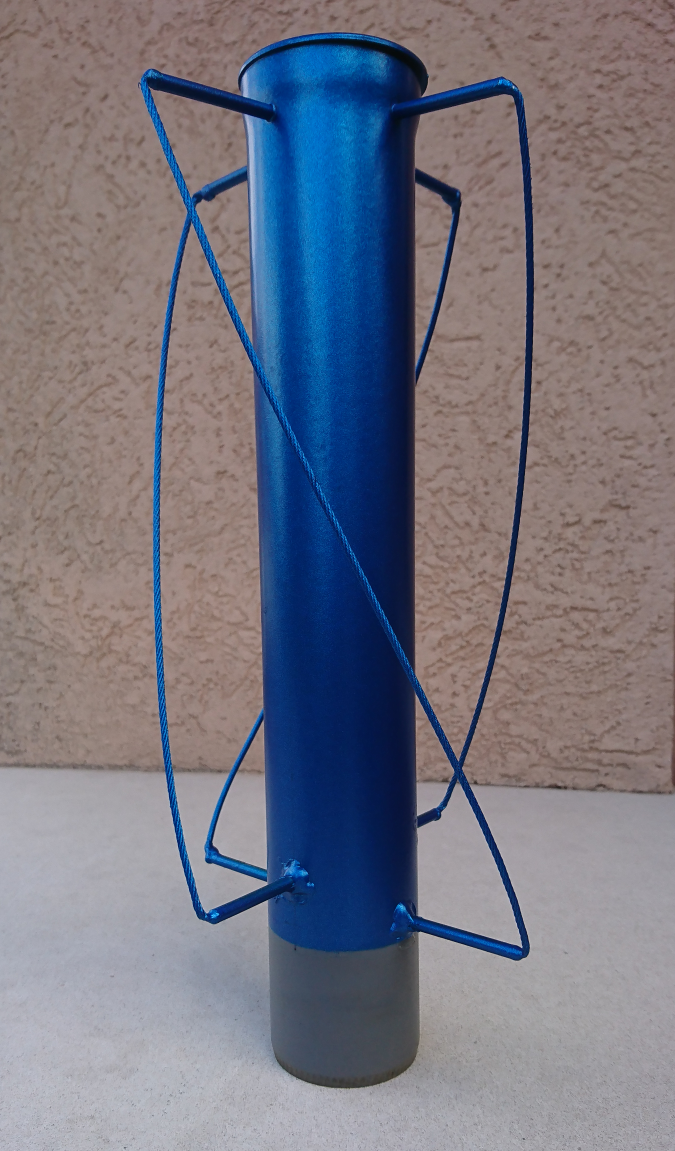
The secret of successful reception is a low noise amplifier. The LNA that was designed by HA5CQA is being made in series in Pista's laboratory and they are helping reception at several tracking stations.
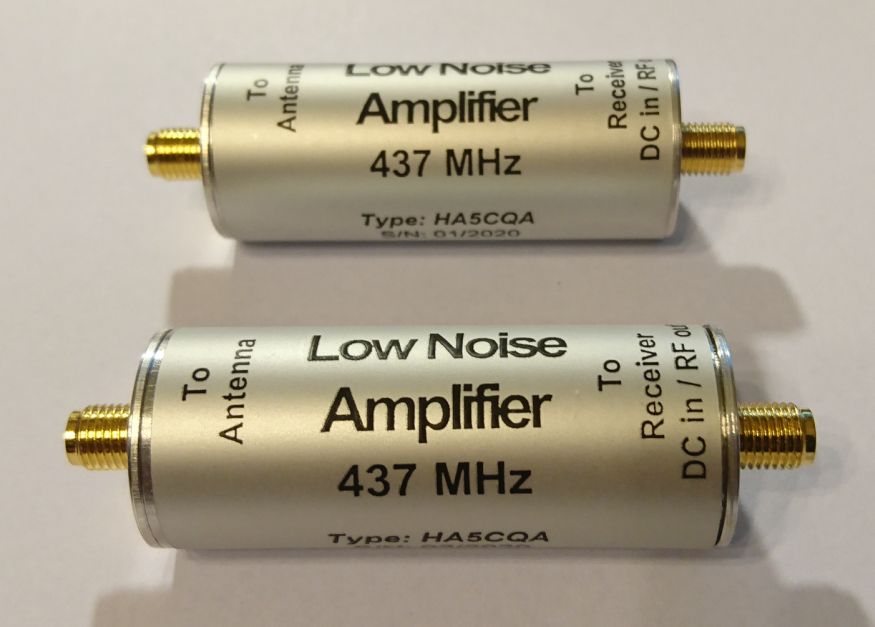
June 18th 2020
HA5WH's article created substantial international interest among scientific circles. The appreciative letters arrive in a row.
http://gnd.bme.hu/smog/files/publikaciok/smogp_spectrum_measurement.pdf
A leader of an ESA working group leader writes:
"Congratulations! You have to be very proud of the excellent work of your team and the results obtained. Also, I appreciate your efforts to communicate the results and increase awareness. Important part sometimes was forgotten."
May 2nd 2020
As early as December 2019, some of us realized that it is possible to receive BME satellites successfully without program-controlled Az / El antennas.
HG5OK was the first to design a QFH antenna that is expected to provide signals of sufficient power from SMOG-P and ATL-1 satellites travelling on higher orbits to record files suitable for decoding to its simple receiver. This antenna is designed for RHCP polarization.
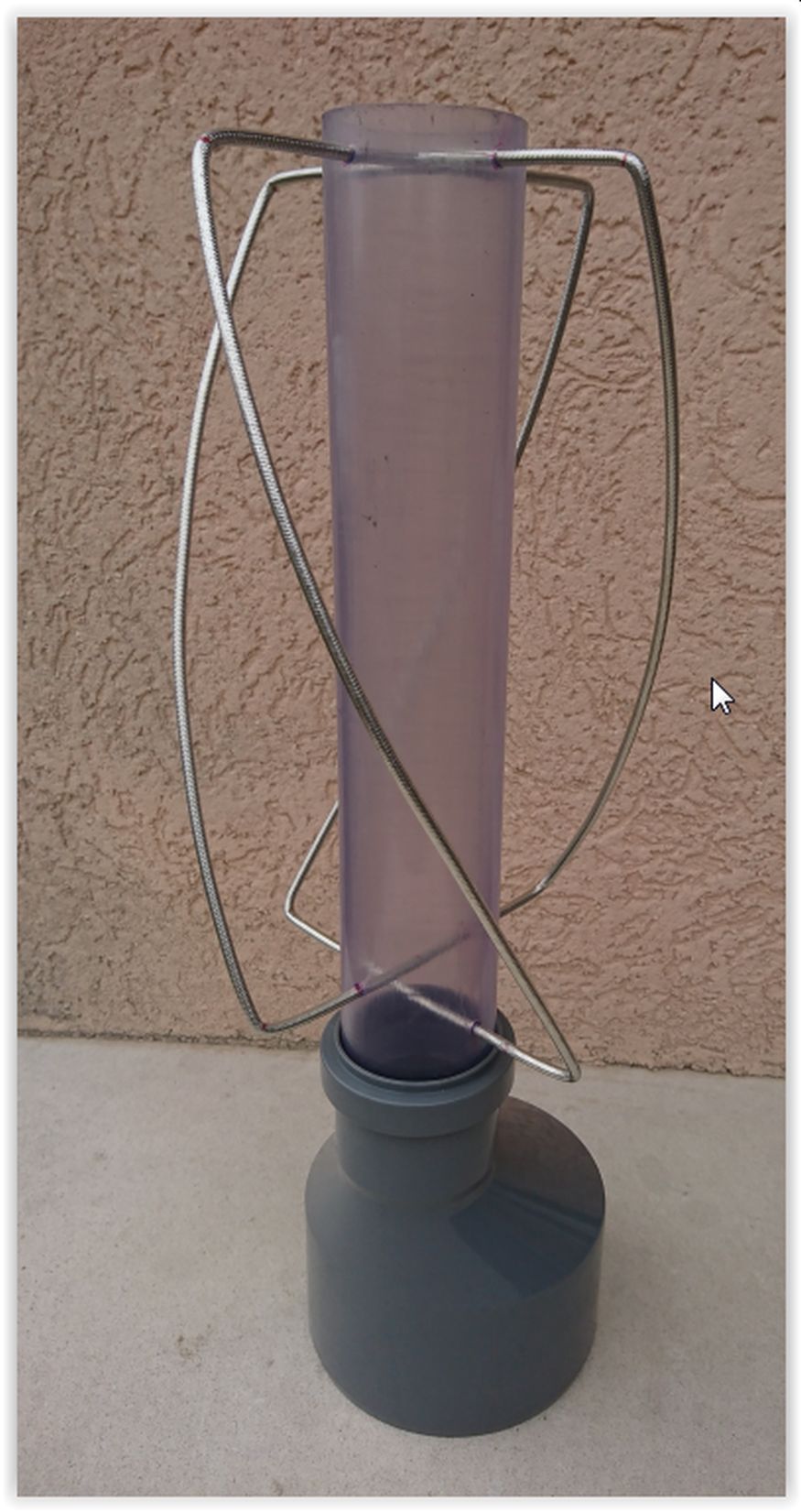
Making these may seem a bit sloppy, so the next experiment was a turnstile antenna, which is a V-shaped cross dipole with their associated reflectors.
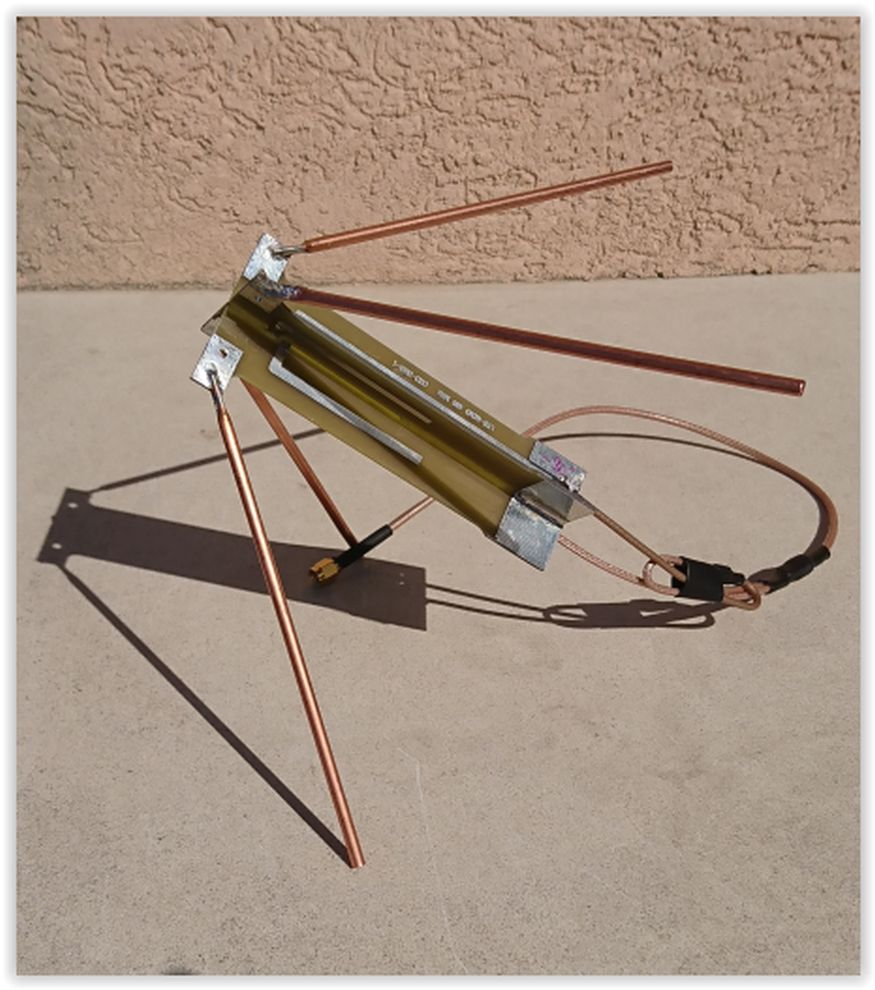
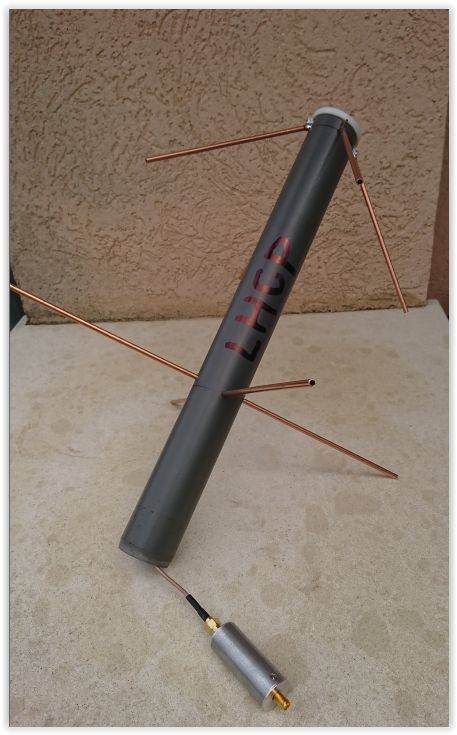
The image to the right shows an assembled antenna for LHCP polarization with the LNA.
As a result of the good reception results, a classic GP antenna with an ordinary quarter-wave radiator was born out of a bold idea.

After this, it has been suggested that when using plane-polarized antennas, it is more advantageous to receive the horizontal or vertical plane, respectively. It proved useful to compare the signals taken in the two planes. That is why the fourth antenna with two cross dipoles was made, the received signals of which are processed by two separate units.

The QFH, the two turnstiles with different polarizations, the GP and the cross dipole, make up the antenna farm.
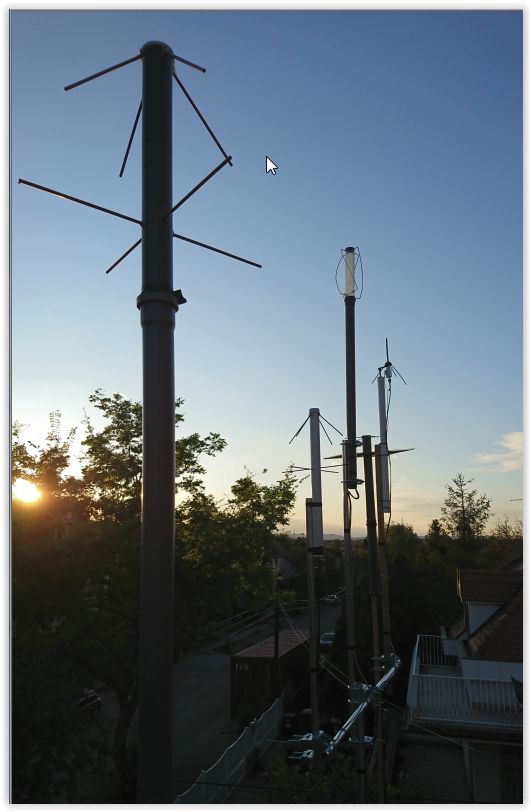
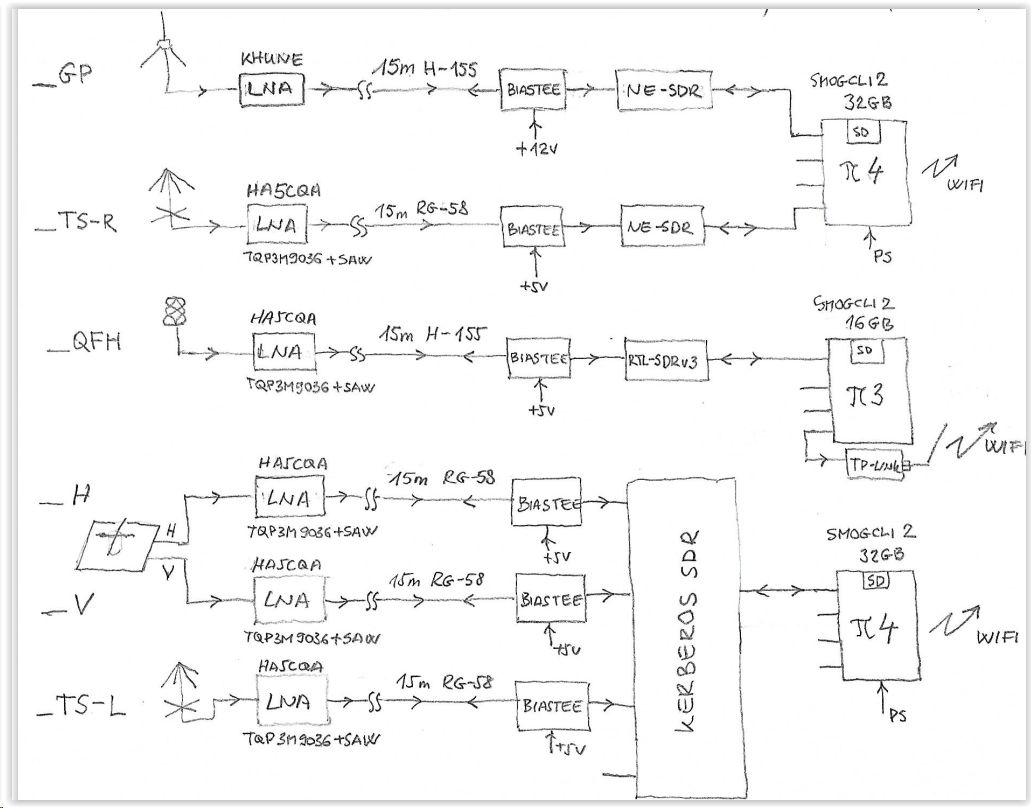
A separately measured band-pass LNA for each antenna, the additional units are shown in the drawing above. The GP LNA is made by Kuhne.

HG5OK's house with all the antennas:
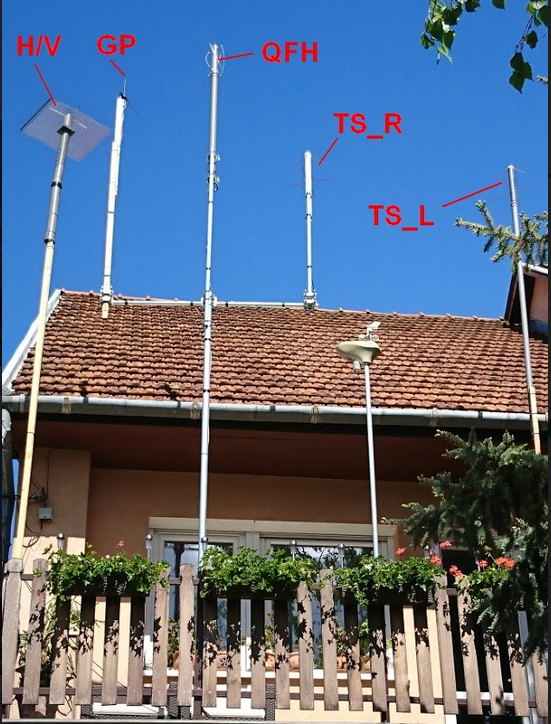
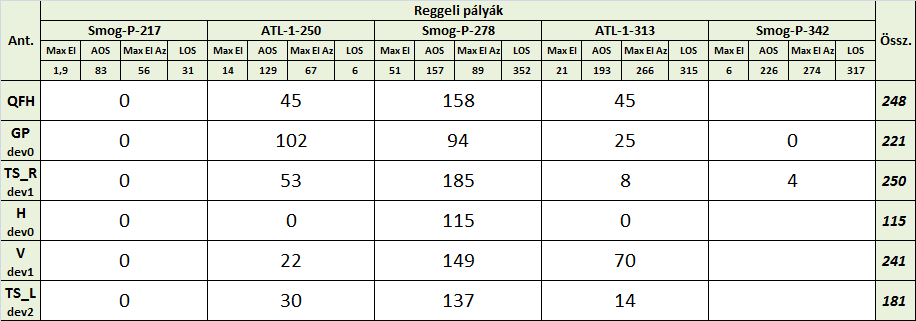
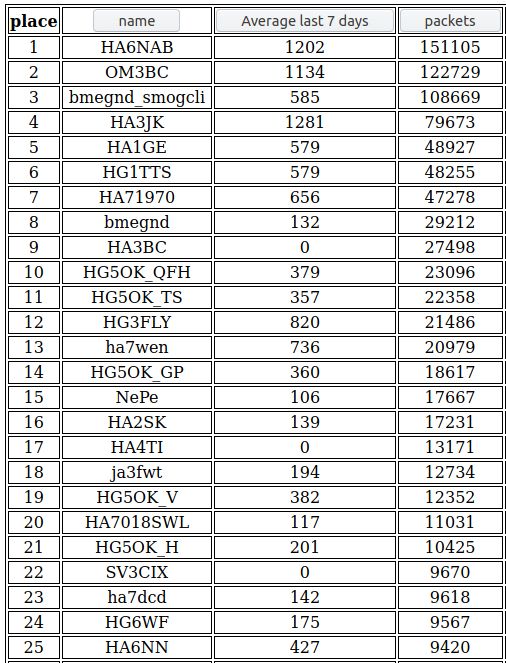
One of the most important parts of the successful application is a software named smogcli2. It can be found at https://gitlab.com/phorvath/smogcli2
HA6NN
2020. április 19.
A MRASZ kezdeményezte speciális hívójelek használatát. Lásd:
HA6NM heti váltásban különböző hívójelekkel fog dolgozni a QO-100 geostacionárius műholdon. A hívójeleknek a végződései (suffix) összeolvasva a STAY AT HOME felszólítást népszerűsítik.
Aki begyűjti a szükséges összeköttetéseket egy oklevelet tölthet le.

2020. április 11.
Nem volt unlis! A QSL-lap is megérkezett.
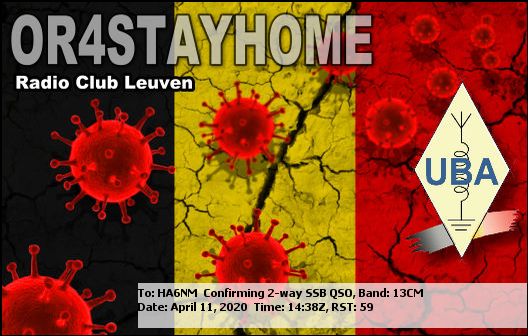
2020. április 9.
E7STAYHOME
Nálam egy valós QSO volt a QO-100-on.
OP: E70T Vlado.
73,
HA6NM
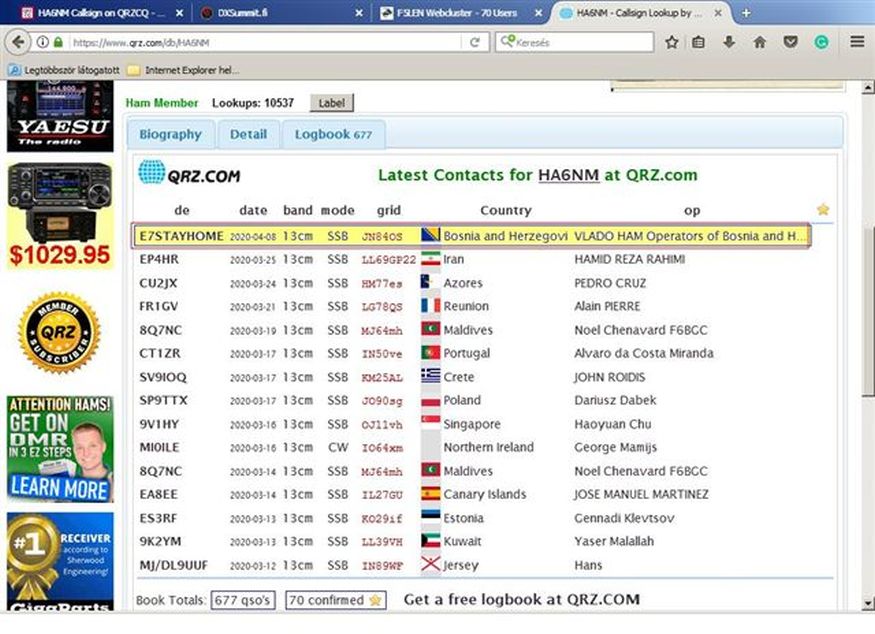
2020. március 29.
Egyre több állomás található a QO-100 geostacionárius műholdon. Talán a sok otthonülő rádiós aktívabb, vagy egyre gyorsabban nő a felhasználók száma.
HA6NM riportja:
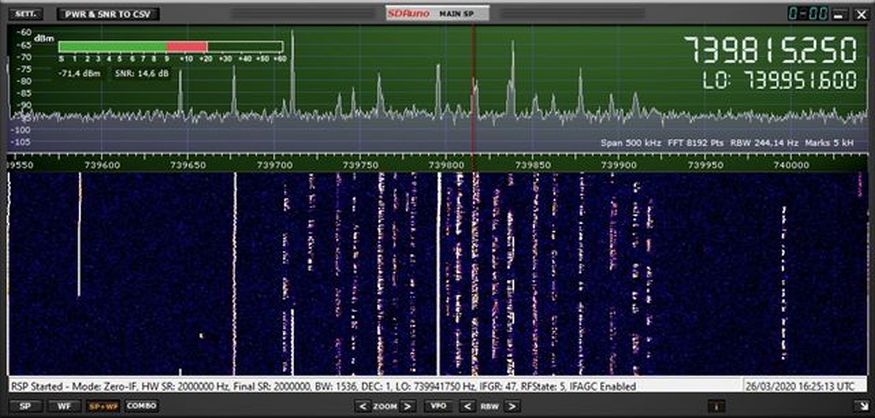
A legfrissebb logkivonat:
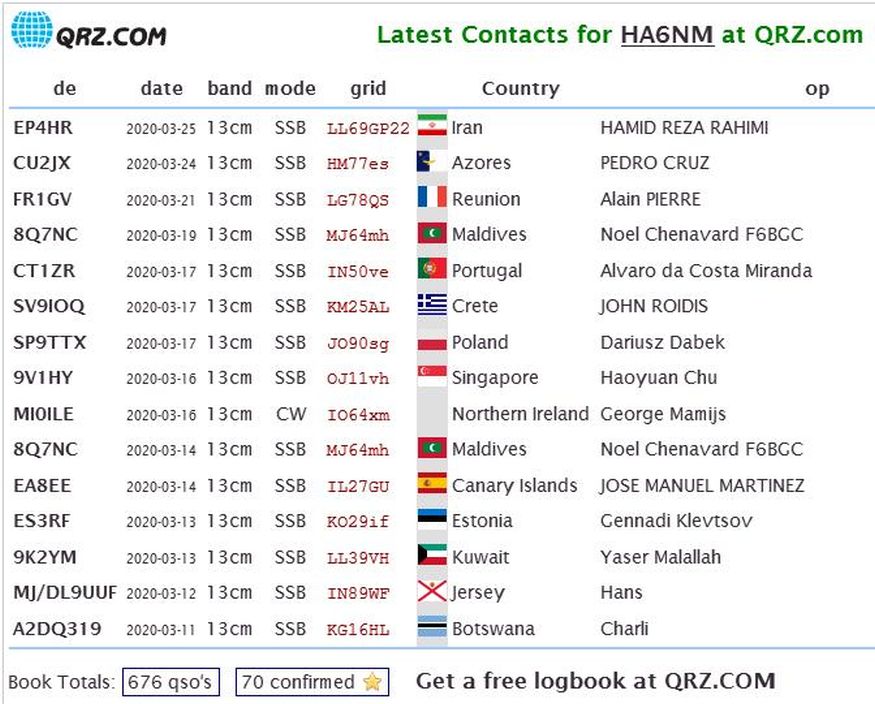
2020. március 26.
A BME-műholdak kitartóan kerülgetik a Földet, a követő állomások pedig igencsak változatos felszereltséggel szorgalmasan gyűjtik a dekódolt, értékes adatokat.
A pole position-ból indult HA6NAB magabiztosan tartja az első helyét és a mai napot már
100378
csomaggal kezdte a reggeli műhold-áthaladások után. A második és harmadik helyezett állomások eddig váltogatták a helyüket de lassan győzni látszik a 4,5 m átmérőjű monstrum. Emil a gnd.bme.hu operátora sikeresen megküzdött a nagy parabola forgatójának a beállításával, így már a fejfeletti átvonulások követése nem okoz gondot.
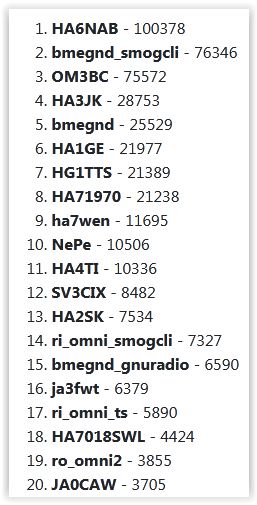
A negyedik helyet a MASAT-1 követése során is HA3JK szerezte meg. Ő lehet az "örök" negyedik. A bmegnd bokros teendői mellett csomagokat is gyűjt, őket egy családi vállalkozás (Apa és fia csak fordított sorrendben.) követi a 7. és a 8. helyen. HA71790, aki a sportszerűségi díjra érdemes, hiszen Users' Guide-ot írt és többeket -de leginkább HA3JK-t tanította meg arra, hogyan használja a szoftvereket. Van aki tanít, van aki tanul az egyetemen, van akiről nem tudjuk, hogy kicsoda.
A külföldi követőállomások listáját SV3CIX vezeti. Ő az egyetlen, aki helix antennát használ.
Gyors előrehaladást ért el HA2SK, aki OM3BC és HA3JK mellett veterán műholdkövető, a MASAT-1 repülése alatt is szorgalmasan gyűjtötte az adatokat.
Nagy figyelmet érdemelnek HA5OK omnidirectional antenna kísérletei. Egyszerű antennákkal -pl. QFH, turnstile és GP- is gyors csomagszám növekedést ért el.
HA7018SWL az erkély-antennájával rövid idő alatt előkelő helyezést szerzett. A japánok sokáig nem voltak eléggé tájékozottak a használható szoftvereket illetően. A smogcli2 egyik alkotója már talált egy japán kapcsolatot, aki az új és hatékony szoftvert az ő nyelvükön is népszerűsíti. JA0CAW a 20. helyen áll, ám tudjuk ő volt az aki először meghallotta a 2019. december 6-án felbocsátott SMOG-P és a ATL-1 adását.
A további 49 helyen még mintegy 20 állomás igyekszik a szerényebb eszközeivel további adatcsomagokat gyűjteni. Figyelemre méltó ws134 és mmaroti kitartó haladása -amellett, hogy bennük tiszteljük a smogcli2 megalkotóit, akik rengeteg időt és tudást invesztáltak a smogcli2 szoftver fejlesztésébe.
HG5OK rengeteg munkával összeállított egy táblázatot, amiben a leaderboard első 40 állomásának az adatait gyűjtötte össze.
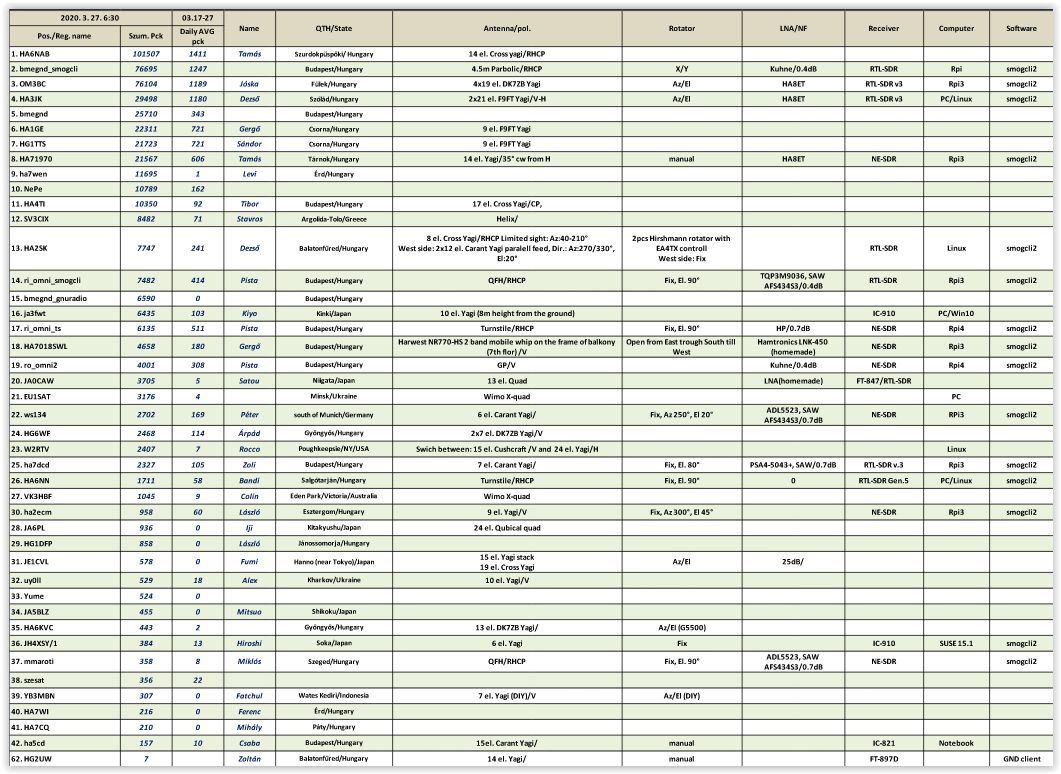
NN